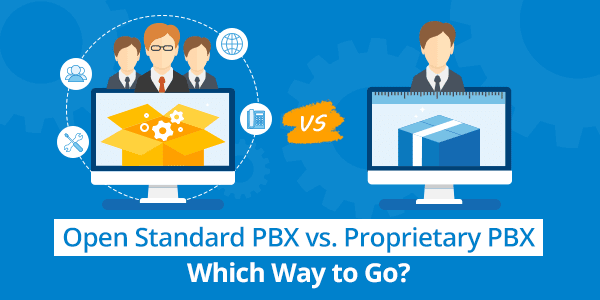Open Standard PBX vs. Proprietary PBX, Which Way to Go?
Your customer wants to overhaul their IP phone system or maybe migrate to one for the first time. Do you go with a proprietary or open standard system? Before you make the choice, it’s important not to immediately dismiss either option. Understanding the ins and outs of each type of system as well as your customer’s specific requirements is essential.

Let’s examine some of the key strengths and disadvantages of each approach.
1. The Positives and Negatives of Open Standard PBX
Breaking the shackles of the proprietary technologies, open-standard PBX systems are open stack solutions leveraging the standard-based approach – for example, SIP – for the transmission of multimedia communications. Widely prevalent and acknowledged for its cross-system usability and flexibility, open-standard PBX systems don’t have many disadvantages for a lot of businesses today. Along with essential telephony features, some leading-edge solutions like Yeastar also boast high-end unified communications out of the box. In general, open-standard PBX systems provide:
Better Value for Money:
An open-standard PBX system is often associated with substantial saving, because it’s simple to manage and, in most cases, there’s little licensing fees to worry about. Compared with proprietary solutions that lock you into long-term service contracts or expensive system overhaul, open-standard solutions can be more cost-effective in many business scenarios.
Eliminate Risk of Vendor Lock-in:
The true value of open-standard PBX come from being able to combine a mix of standard components to deliver innovative service. You can use almost any SIP phone, gateway or standard-based peripherals with the system, which contributes to user satisfaction and business productivity.
Easier to Install and Configure:
If you are using a proprietary phone system, you will probably already know the difficulties that occur when trying to install, use and maintain it. Instead, open-standard PBX systems are easy to use and manage. This can be especially true for those Asterisk-based ones with intuitive front-end GUI.
Interoperability and Customization:
Customization is a big deal-breaker when it comes to phone systems. And open-standard PBXs win on this point. It’s relatively easy to integrate with other standard-based applications such as databases, CRM, hotel PMS, call center and others to fulfill specific customer needs.
Although open-standard PBX systems, by and large, don’t have many disadvantages, the whole system quality is highly dependent on vendors. Some free open solutions are claimed deficient in desired functions, professional support and frequent updates. It’s therefore important to choose a reliable brand with a large customer base, state-of-the-art R&D resources and dedicated support team.
2. The Positives and Negatives of Proprietary PBX
Proprietary PBX are “closed” system designed specifically by manufacturers, complete with their own branding. Most of the proprietary solutions like NEC or Panasonic are considered relatively reliable yet less attractive from a financial perspective. With a proprietary system, you get nearly all your hardware/software from one vendor, who’ll support and warranty everything from the PBX to handsets. As such, some of the benefits include:
Uniform User Experience:
In most cases, proprietary systems offer a uniform user experience. The whole VoIP system remains consistent across compatible hardware and software applications. So, you can expect a similar and familiar user experience with each device.
Manufacturer Support:
With a proprietary system, your vendor has sole control over the updates, upgrades and modifications. As a corollary to this, you, as a reseller/distributor, might have greater control over the customers, but you’ll need to invest more resources to master the complicated proprietary systems and interfaces for better customer support.
Alongside the benefits proprietary solution offer, there are some disadvantages can’t be neglected. The biggest ones may come with the costs, the risk of vendor lock-in, and limited flexibility. Many proprietary products can only function properly when used with other products owned by the same manufacturer. In other words, you’re likely to be held hostage to proprietary handsets and peripherals that might be overpriced with limited-functionality, which will bring negative effects to the sales process.
Another main thing to remember is that with a proprietary PBX system, you may not be able to achieve the same level of flexibility as open-standard solutions. Because proprietary ones usually don’t allow for developer workarounds specific to the problem, likely, you will not be able to implement the smallest changes required to better adapt the solution to your business needs. And when complicated issues arise, your vendor is your only backup.
3. Forethought: Business Ecosystem and Potentials
With the ever-expanding horizon and advances in the VoIP market, the key for a phone system to stay ahead is to keep pace with the market trends and offer viable solutions to fit into the larger universe of customer demands. And it’s undeniable that open-standard solutions have competitive edges.
Proprietary’s role as the primary innovator in the market has gone to the wayside. The prevalence of industrial open-standards such as SIP and open source telephony like Asterisk had revolutionized the ecosystem and brings more business potentials.
By leveraging the collective efforts from a vast global community of experts, emerging non-proprietary – i.e., open-standard – systems are gaining momentum. They bring benefits associated with open SIP and open source: stability, rapid development, flexibility, and, most importantly, cost savings. Professional open-standard PBX system like Yeastar that combines the flexibility of open source with the professionalism of proprietary solutions are widely welcomed.
With open-standard solutions being continuously developed, users are now given more freedom to inter-operate multiple applications and integrate data systems. Increasingly, integrators want them and end-users demand them for a higher level of price-performance value and eliminated risk of vendor lock-in. Although proprietary technologies still have their market share, the rising market demand for a more flexible solution will eventually tilt the balance.
The Bottom line
Both proprietary and open-standard systems have clear strengths. It’s important to know your customers and understand their needs. How much can they afford a new telephone system? What level of flexibility and customization do they require? Do they have in-house expertise for system maintenance? Asking the right questions will make the choice easier to offer a best-fit solution. After all, it’s customers who have the final say for a deal.







